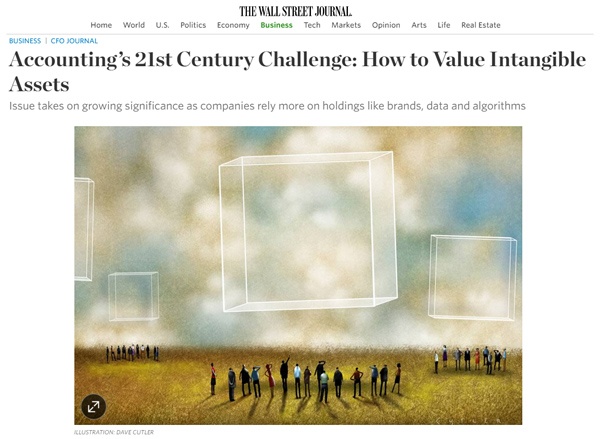How do you attach a price tag to something you can’t see or touch?
This question was posed recently by corporate finance writer Vipal Monga in his WSJ.com article, “Accounting’s 21st Century Challenge: How to Value Intangible Assets.”
 He continues: “The question is increasingly significant for investors as more companies collect information about their customers and use it to develop products and services. Some companies rely on the hipness of their brands to propel sales. Assigning a value to a physical asset like a store or equipment is relatively easy. But, in the murky world of intangible assets, the calculations are squishy. The problem of how to value such assets has vexed accountants for decades.
He continues: “The question is increasingly significant for investors as more companies collect information about their customers and use it to develop products and services. Some companies rely on the hipness of their brands to propel sales. Assigning a value to a physical asset like a store or equipment is relatively easy. But, in the murky world of intangible assets, the calculations are squishy. The problem of how to value such assets has vexed accountants for decades.
“… Some investors and analysts say they don’t need to know the specific value of intangible assets like data. They say a company’s stock price reflects the market’s appraisal of those assets.”
MASB President Meg Blair submitted this response:
“Given Brands are among the most valuable intangible assets owned by any company, both those acquired and those developed internally should be accounted for in financial reporting (and adjusted up or down at least annually), whether it be on the balance sheet or in the MD&A notes.
“The Marketing Accountability Standards Board (MASB) recently completed a multi-year standards project establishing an empirically based model for valuing brands, informing investment decisions, and quantifying some of the “intangibles.” The methodology is simple, transparent, practical and consistent over time, starting with a behavioral measure of consumer brand strength and ending with projections of future cash flows.
“Since we have to start somewhere in accounting for the intangibles, it makes sense to start with brands, which would also lend credibility to the tremendous amount of money spent on marketing to maintain and grow them.”
